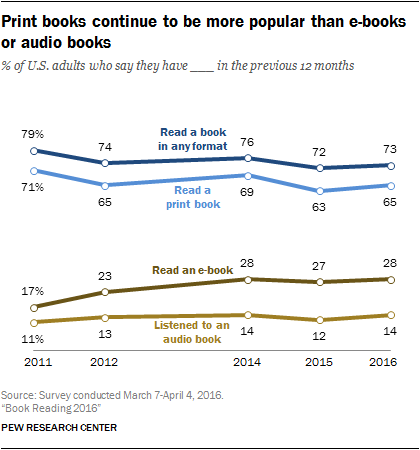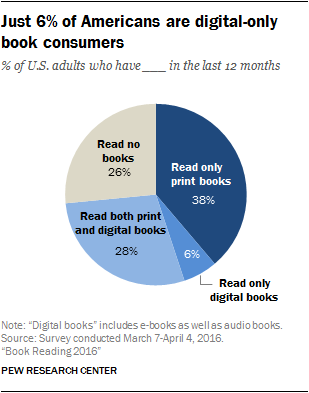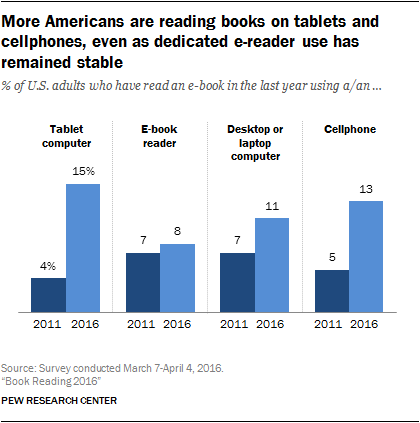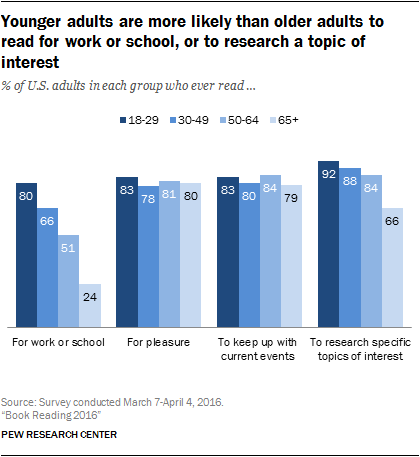How Many Oeople Read More Than 1 Book a Year
 Americans today have an enormous variety of content available to them at any fourth dimension of solar day, and this material is bachelor in a number of formats and through a range of digitally connected devices. Nevertheless fifty-fifty as the number of means people spend their time has expanded, a Pew Research Center survey finds that the share of Americans who have read a volume in the last 12 months (73%) has remained largely unchanged since 2012. And when people achieve for a volume, it is much more likely to be a traditional print book than a digital product. Fully 65% of Americans take read a print volume in the last twelvemonth, more double the share that has read an e-book (28%) and more than than four times the share that has consumed book content via sound book (14%).
Americans today have an enormous variety of content available to them at any fourth dimension of solar day, and this material is bachelor in a number of formats and through a range of digitally connected devices. Nevertheless fifty-fifty as the number of means people spend their time has expanded, a Pew Research Center survey finds that the share of Americans who have read a volume in the last 12 months (73%) has remained largely unchanged since 2012. And when people achieve for a volume, it is much more likely to be a traditional print book than a digital product. Fully 65% of Americans take read a print volume in the last twelvemonth, more double the share that has read an e-book (28%) and more than than four times the share that has consumed book content via sound book (14%).
But while print remains at the eye of the volume-reading mural as a whole, at that place has been a distinct shift in the eastward-book landscape over the concluding five years. Americans increasingly turn to multipurpose devices such as smartphones and tablet computers – rather than dedicated eastward-readers – when they engage with east-book content. The share of e-book readers on tablets has more than than tripled since 2011 and the number of readers on phones has more than doubled over that time, while the share reading on east-volume reading devices has not changed. And smartphones are playing an peculiarly prominent role in the e-reading habits of certain demographic groups, such as not-whites and those who have not attended higher.
These are among the chief findings of a nationally representative telephone survey of 1,520 American adults conducted March vii-April four, 2016.
The share of Americans who have read a volume in the last year is largely unchanged since 2012; more Americans read print books than either read e-books or listen to sound books
Following a slight overall refuse in book readership between 2011 and 2012, the share of American adults who read books in whatsoever format has remained largely unchanged over the last four years. Some 73% of Americans report that they have read at least one volume in the last year. That is nigh identical to the 74% who reported doing then in a survey conducted in 2012, although lower than the 79% who reported doing then in 2011.
Americans read an average (hateful) of 12 books per twelvemonth, while the typical (median) American has read iv books in the terminal 12 months. Each of these figures is largely unchanged since 2011, when Pew Research Eye start began conducting surveys of Americans' book reading habits (for additional details on the number of books read per twelvemonth by unlike demographic groups, see Appendix A).
Readers today can access books in several common digital formats, but print books remain substantially more popular than either eastward-books or audio books. Roughly two-thirds of Americans (65%) have read a print book in the last yr, which is identical to the share of Americans who reported doing so in 2012 (although down slightly from the 71% who reported reading a impress book in 2011).
Past contrast, 28% of Americans take read an e-book – and xiv% have listened to an audio volume – in the last year. In add-on to existence less pop than impress books overall, the share of Americans who read e-books or listen to sound books has remained fairly stable in recent years.
E-book readership increased by xi-percentage points between 2011 and 2022 (from 17% to 28%) merely has seen no change in the terminal two years. Similarly, the share of American adults who listen to sound books has changed simply marginally since Pew Research Center first asked about this topic in 2011 – at that point, 11% of Americans had listened to an audio book in the last year, compared with 14% at present.
Nearly four-in-ten Americans read impress books exclusively; just six% are digital-only book readers
In full, 34% of Americans have either read an eastward-book or listened to an audio volume in the concluding yr, merely relatively few Americans read books in these digital formats to the exclusion of print books.
 More than than one-quarter (28%) of Americans read books in both print and digital formats (which includes due east-books and audio books). Some 38% read print books but did not read books in any digital formats, while just 6% read digital books but non print books.
More than than one-quarter (28%) of Americans read books in both print and digital formats (which includes due east-books and audio books). Some 38% read print books but did not read books in any digital formats, while just 6% read digital books but non print books.
Relatively few Americans are "digital-only" book readers regardless of their demographic characteristics. However, some demographic groups are slightly more likely than others to practice all of their reading in digital format. For instance, 7% of higher graduates are digital-only book readers (compared with but iii% of those who have not graduated from high school), equally are 8% of those with almanac household incomes of $75,000 or more (compared with three% of Americans with incomes of $30,000 or less). Interestingly, young adults are no more likely than older adults to be "digital-only" volume readers: 6% of 18- to 29-twelvemonth-olds read books in digital formats only, compared with 7% of thirty- to 49-year-olds and 5% of those 50 and older.
College graduates are roughly four times as likely to read e-books and about twice as likely to read impress books and sound books – compared with those who accept not graduated loftier schoolhouse
 As was the case in previous Pew Research Centre surveys on book reading, sure groups of Americans read at relatively loftier rates and in a wide variety of formats. These include:
As was the case in previous Pew Research Centre surveys on book reading, sure groups of Americans read at relatively loftier rates and in a wide variety of formats. These include:
College graduates – Compared with those who accept not attended college, college graduates are more than probable to read books in full general, more likely to read print books, and more likely to swallow digital-volume content. The typical (median) higher graduate has read 7 books in the last year.
Young adults – 80% of 18- to 29-year-olds have read a volume in the last twelvemonth, compared with 67% of those 65 and older. These young adults are more than probable than their elders to read books in various digital formats, but are as well more likely to read print books also: 72% take read a print book in the last year, compared with 61% of seniors.1
Women – Women are more than likely than men to read books in full general and as well more than probable to read print books. However, men and women are equally likely to read digital-format books such every bit e-books and audio books.
The share of Americans who read books on tablets or cellphones has increased substantially since 2011, while the share using defended east-readers has remained stable
 Tablet computer and smartphone ownership accept each increased dramatically in contempo years, and a growing share of Americans are using these multipurpose mobile devices – rather than dedicated east-readers – to read books. Between 2011 and 2016, the number of Americans who read books on tablet computers has increased nearly fourfold (from 4% to xv%), while the share who read books on smartphones has more than than doubled (from 5% to 13%). The share of Americans who read books on desktop or laptop computers has also increased, although by a more than pocket-size amount: xi% of Americans now exercise this, up from seven% in 2011.
Tablet computer and smartphone ownership accept each increased dramatically in contempo years, and a growing share of Americans are using these multipurpose mobile devices – rather than dedicated east-readers – to read books. Between 2011 and 2016, the number of Americans who read books on tablet computers has increased nearly fourfold (from 4% to xv%), while the share who read books on smartphones has more than than doubled (from 5% to 13%). The share of Americans who read books on desktop or laptop computers has also increased, although by a more than pocket-size amount: xi% of Americans now exercise this, up from seven% in 2011.
Past dissimilarity, 8% of Americans now report that they read books using dedicated e-reader devices – nearly identical to the 7% who reported doing so in 2011.
About 1-in-five Americans nether the age of 50 have used a cellphone to read eastward-books; blacks and Americans who take non attended higher are particularly likely to turn to cellphone – rather than other digital devices – when reading eastward-books
 Previous Pew Research Center studies have documented how several groups – such equally blacks and Latinos, and those who accept not attended college – tend to rely heavily on smartphones for online admission. And in the context of book reading, members of these groups are especially likely to turn to smartphones – rather than tablets or other types of digital devices – when they appoint with e-book content.
Previous Pew Research Center studies have documented how several groups – such equally blacks and Latinos, and those who accept not attended college – tend to rely heavily on smartphones for online admission. And in the context of book reading, members of these groups are especially likely to turn to smartphones – rather than tablets or other types of digital devices – when they appoint with e-book content.
For instance, 16% of blacks report that they use their cellphones to read books. That is almost double the share of blacks who read books on traditional computers (9%) and four times the share who read books using dedicated e-readers (4%). Hispanics are less likely than blacks as a whole to read books on cellphones (11% exercise so), but Hispanics are also substantially more likely to read books on cellphones than on e-readers or traditional computers. By contrast, whites tend to plow to a range of digital devices when reading e-books: 13% read e-books on cellphones, but 18% read e-books on tablet computers, 10% use due east-book readers and 11% engage with e-book content on desktop or laptop computers.
Cellphones also play a relatively prominent part in the reading habits of Americans who have not attended college. Higher graduates are far more likely than those with loftier schoolhouse diplomas or less to read books on tablets (25% vs. 7%), eastward-volume readers (15% vs. 3%) or traditional computers (xv% vs. 6%). Merely these differences are much less pronounced when information technology comes to reading books on cellphones. Some 17% of college graduates read books this way, compared with 11% of those with high school diplomas or less – just a 6-percent point divergence.
Along with these groups, Americans under the historic period of 50 are especially likely to consume due east-volume content on cell phones: one-in-5 (19%) practise so, compared with 9% of 50- to 64-twelvemonth-olds and but 4% of those 65 and older.
The share of Americans who read in order to enquiry a specific topic of interest has increased in recent years
 In improver to asking whether – and on what devices – Americans read books specifically, the survey likewise included a broader set of questions asking about reasons that people might read written content of whatsoever kind (including books, but as well magazines, newspapers or online content).
In improver to asking whether – and on what devices – Americans read books specifically, the survey likewise included a broader set of questions asking about reasons that people might read written content of whatsoever kind (including books, but as well magazines, newspapers or online content).
Amid all American adults:
- 84% ever read to research specific topics of involvement (29% practise so nearly every day).
- 82% read to keep up with current events (47% nearly every day).
- 80% read for pleasance (35% nearly every 24-hour interval).
- 57% read for piece of work or school (31% practise so nearly every 24-hour interval).
A similar share of Americans study that they read for pleasance, for work or school, or to proceed up with current events compared to the virtually contempo time these questions were asked in 2011. Nevertheless, the share of Americans who read in order to research specific topics of interest has increased by 10-percent points over that time frame, from 74% to 84%.
Older and younger adults are equally probable to read for pleasance or to continue upwardly with electric current events; younger adults are more than likely to read for work or school, or to inquiry a topic of interest
 In some cases, the factors associated with high rates of volume readership are the same ones associated with reading for specific purposes. For example, college graduates are more probable than those who have merely attended high school to read books in general – and they are also more likely to read for all iv of the specific motivations examined in this survey.
In some cases, the factors associated with high rates of volume readership are the same ones associated with reading for specific purposes. For example, college graduates are more probable than those who have merely attended high school to read books in general – and they are also more likely to read for all iv of the specific motivations examined in this survey.
At the same fourth dimension, in that location is non always such a direct relationship between book reading and overall reading for specific purposes. Every bit noted earlier in this report, young adults are more likely to read books than older adults. And when asked about specific reasons why they might read a range of content, these immature adults are much more than likely than older adults to say that they read for piece of work or school, or to inquiry a specific topic of interest. Notwithstanding, Americans of all ages are equally probable to indicate that they read (whether in volume form or otherwise) for pleasure or to keep up with current events.
Source: https://www.pewresearch.org/internet/2016/09/01/book-reading-2016/
0 Response to "How Many Oeople Read More Than 1 Book a Year"
Post a Comment